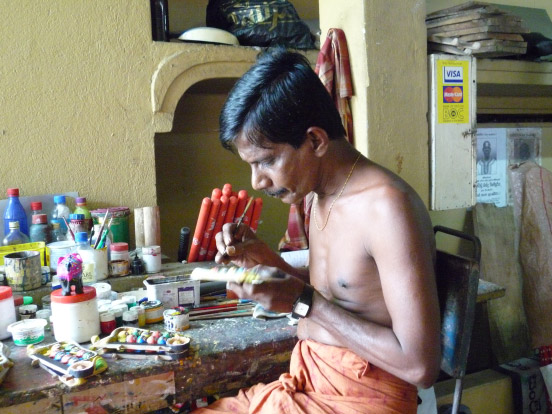|
Naga Raksha is the mirror of the soul
Dec 18, 2009 By Peter Morner | |
|
On the southwest coast of Sri Lanka, only eighty miles south of the metropolis Colombo, is a small place Ambalangoda. In him are hidden demons of all kinds just looking for demons of the struggle in vain - after the end of the Civil War are the peacemakers instead at a premium. Centuries-old traditions and the spirit of Buddha here in the old-established families Maskenschnitzerei their expression. The workshop of Wijesuriya clan, which is now owned and run by the fifth generation, looks like a larger garage. Before her stands Shashika Perera. The petite lady is solely responsible for the permanent exhibition in Ambalangoda mask, which is sponsored by the Museum of Ethnology in Berlin and the Foreign Office.
Shashika speaks softly, and, more to herself: "If a traveler from very far away from America or Europe, only to wave or riding elephants coming to our small country that is Buddha, who is Sri Lanka, who will understand the Sinhalese and Tamils never . This applies also and especially for the Maskenschnitzen. Selecting the bright, fast growing and very easy to work kaduru-wood was for the people here, like the drying of the material in the sun, smoking against pests and editing with a saw, hammer and chisel natural routine. "But there is a secret behind it," says Perera Shashika. "I observe daily how our artists are buried in each mask again her own soul." Beauty and Philosophy Shashika Perera explains what she means by this: If the face mask wear an angry expression, then the artist will also be up to the angry intolerable. He cut about a vengeful eye in the head of Prince Maha Kola, take on the traits of the carver, the expression of blood thirst. Shashika reiterated her words once again when she could not even quite believe what she says: "No, it's not the technology, it is the special spirit that the highly complex philosophy of Buddha, which separates the bungler, the dilettantes from the true artist . The great genius of the family Wijesuriya are of course not just any mask carver. They are as dancers, musicians and teachers. you love and cherish their philosophy and they pass on from one generation to the next. "
Transformed into poisonous snakes
Anyone who can inspire not only from the masks, but also by the ancient dances of the Sinhalese, who will realize very quickly that this is about much more than just about the representation of the rice harvest by graceful girl. He suffered through the death and the masked devil dances emerge. And who, after having admired the fifty feet high, and thus the country's largest Buddha statue in the temple of Dikwella, strolling through the "Schaudergang" the annex, to convey an impression of the mural, which is capable of torture, phantasies, man.
Dancing around the patient
In Sri Lanka there are demons specialists for almost all situations. They are called around to the bed of a fever patient, and then ask the competent demon Ginijala Sanniya to himself. The demon is sacrificed, so he quickly leaves the patient's body. After the demon must dance before the assembled family, he was released with a lot of great debt of gratitude in all honor and all courtesy. But what triggered this terrible disease demons Ayurveda, celebrated on the island of the doctrine of salvation? In the Ayurvedic physician Dr. Danister L. Perera, they are far cheaper voodoo magic. Rather, the expression of a demon viewing and mode of treatment are sick people is fundamentally different from Western medicine. "Many Westerners define the body as a purely mechanical machine. By contrast, we see in each patient an individual being, the family is placed in the society. Every person is unique even in his illness," he says.
The theory of harmony
According to this philosophy, all work Ayurvedic physicians in Sri Lanka. The choice of food, the healing oils, cleaning powders and pills, special herbal baths, massage is to bring the individual in conjunction with meditation and yoga body and soul to unity and hence to harmony and accord. The Europeans often mysterious looking for Ayurvedic medicine, it is as well, which contributes to the moment that Western tourism to the poverty-stricken Sri Lanka has once again become a top prospect.
Memories of war
Courtesy: faz.net |
|
|
| |

